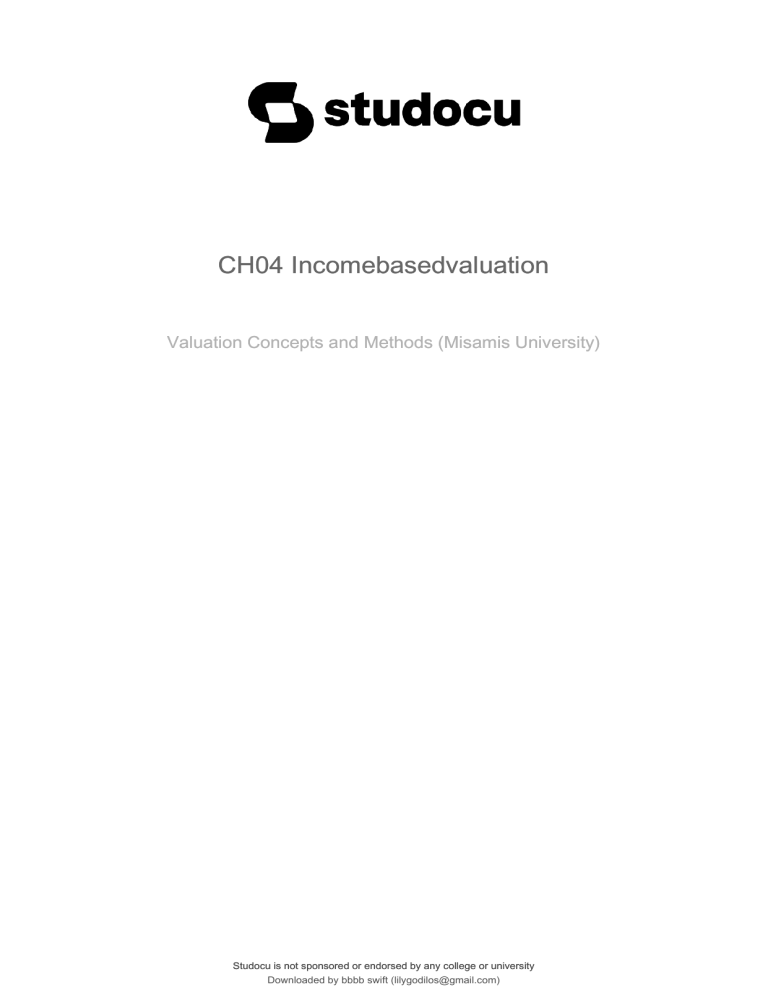Income-Based Valuation: Concepts & Methods
advertisement

lOMoARcPSD|18231773 CH04 Incomebasedvaluation Valuation Concepts and Methods (Misamis University) Studocu is not sponsored or endorsed by any college or university Downloaded by bbbb swift (lilygodilos@gmail.com) lOMoARcPSD|18231773 Computations: VALMET Chapter 4 Income Based Valuation Many investors and analysts find that the best estimate for the value of the company or an asset is the value of the returns that it will yield or income that it will generate. Income- based on the amount of money that the company or the assets will generate over the period of time. In income-based valuation, investors consider two opposing theories: 1.Dividend Irrelevance Theory- stock prices are not affected by dividends or the returns on the stock but more on the ability and sustainability of the asset or company. 2.Bird-in-the hand Theory -dividend or capital gains has an impact on the price of the stock. Factors that can be considered to properly value the asset: i. ii. iii. Earning accretion or dilution Equity control premium Precedent transactions Earning Accretion- additional value inputted in the calculation that would account for the increase in value of the firm due to other quantifiable attributes like potential growth, increase in prices, and even operating efficiencies. Equity Control Premium- an amount that is added to the value of the firm in order to gain control of it. Weighted Average Cost of Capital WACC Capital Asset Pricing model Weighted Average Cost of Capital (WACC) formula can be used in determining the minimum required return. It can be used to determine the appropriate cost of capital by weighing the portion of the asset funded through equity and debt. WACC= (ke x We) + (ka x Wd) Ke= Cost of equity We= weight of equity financing Kd= cost of debt after tax Wd= weight of the debt financing -WACC may also include other sources of financing like preferred stock and retained earnings. Including other sources of financing will have to require redistributing the weight based on the contribution of the asset. The cost of equity may also be derived using Capital Asset Pricing Model or CAPM. ECONOMIC VALUE ADDED The most conventional way to determine the value of the asset is through its economic value added. In economics and financial management, Economic Value Added (EVA) is a convenient metric in evaluating investment as it quickly measures the ability of the firm to support its cost of capital using its earnings. Elements that must be considered in using EVA: -Reasonableness of earnings or returns Precedent transactions- are previous deals or experiences that can be similar to the investment being evaluated. Cost Capital- a key driver in the income-based approach. -Appropriate cost of capital EVA= Earnings – Cost of Capital Cost of Capital= Investment value x Rate of Cost Capital Downloaded by bbbb swift (lilygodilos@gmail.com) lOMoARcPSD|18231773 Capitalization of Earnings Method - is an income-oriented approach. This method is used to value a business based on the future estimated benefits, normally using some measure of earnings or cash flows to be generated by the company. Equity Value= Future Earnings/ Required Return -This method assumes all of the assets, both tangible and intangible, are indistinguishable parts of the business and does not attempt to separate their values DISCOUNTED EARNINGS/CASH FLOWS METHOD The Discounted Earnings Method is sometimes referred to as the Discounted Cash Flow Method, which suggests the only type of earnings to be valued, using this method, would be some definition of cash flow, such as operating cash flow, after-tax cash flow or discretionary cash flow. The Discounted Earnings Method is more general in its definition as to the type of earnings that can be used. The Discounted Earnings Method is an incomeoriented approach. It is based on thetheory that the total value of a business is the present value of its projected future earnings, plus the present value of the terminal valu Downloaded by bbbb swift (lilygodilos@gmail.com)


